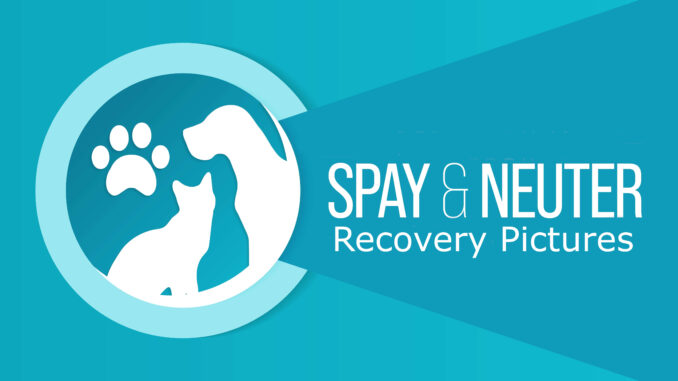
This article was updated on June 22nd, 2024

Spay and neuter surgeries are some of the most common surgeries performed by veterinarians. However, even though your veterinarian likely performs them every week, it can be a nerve-racking experience for pet parents. In this article, our veterinarians curated pictures to show examples of normal (and abnormal) spay or neuter incisions and scars.
What a normal spay or neuter incision looks like [with pictures]
The image below depicts a surgery site immediately after surgery. The skin around the incision will be normal or slightly pink in color, and the edges should be touching each other. A slight amount of blood may seep intermittently within the first 24 hours but should not be continuous or excessive.
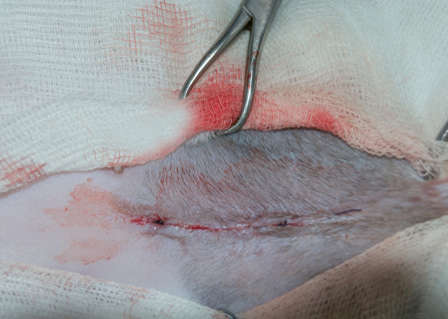
Over the next couple of days, as the healing process begins, the skin may become slightly redder.
A small amount of bruising and scabbing is also normal in the days following surgery.
Pictured below: This amount of bruising looks a bit scary to most owners, but can be normal after surgery, especially in a cryptorchid (undescended testicles) neuter. However, it should be brought to your vet’s attention at the routine recheck appointment, or you can send a picture to your veterinarian for guidance.
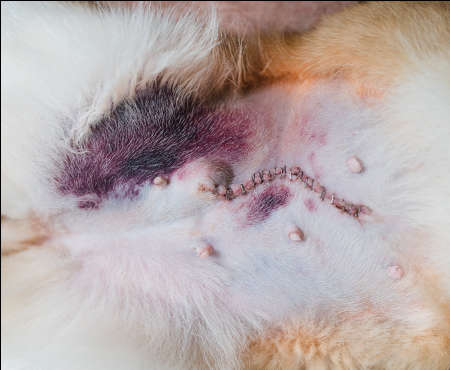
To help decrease bruising it’s important to keep your dog calm and quiet after surgery and use an e-collar when unsupervised (read our tips later in this article). Other causes of significant bruising can include an underlying clotting disorder.
Picture of a normal incision with external sutures
After the ovaries and uterus are removed, a spay incision will be closed with a suture or stitch, in several layers. The top layer, which is your dog’s skin, is most often closed with an absorbable suture within the skin. The sutures will not be visible and will dissolve over time. Below is an incision that was closed with external sutures (placed on the outside of the skin):
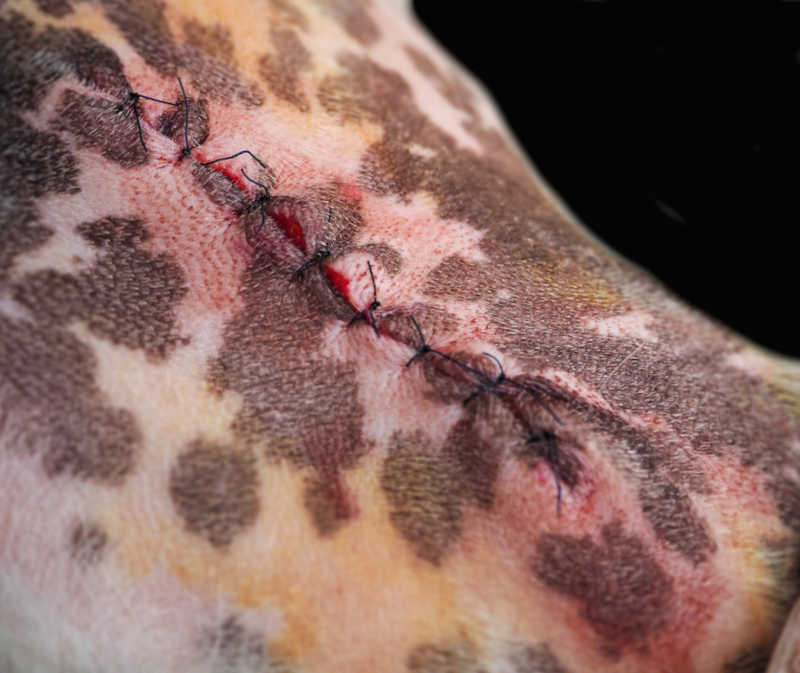
Pictures of incisions that are nearly healed
The neuter incision below is almost fully healed. There should be no sign of discharge or swelling, and the incision should be fully closed and painless to the touch.
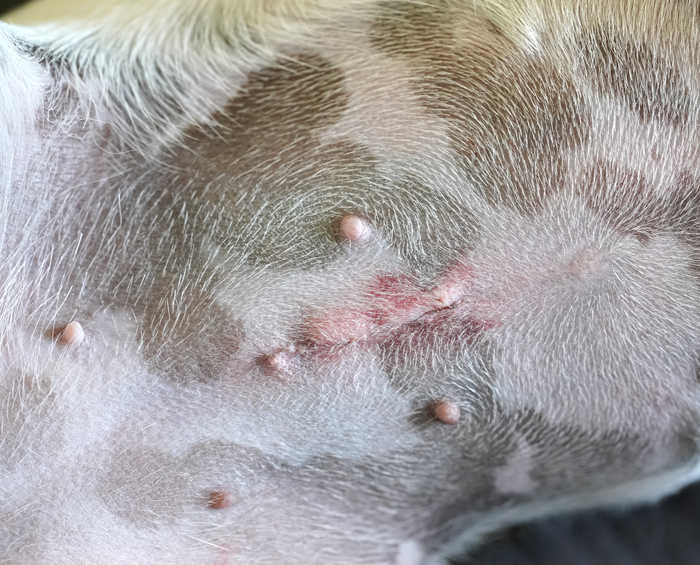
“If you see redness, streaking, swelling, or discharge from the incision, you need to contact your veterinarian.”
Spay & neuter incision healing timeline: day by day (with pictures)
First case: healing process of an incision after a spay or neuter surgery
These images below show a normal progression of healing for an incision/scar after a spay surgery.
Day 1-2
Immediately after surgery, the skin may be slightly pink, and there may be a small amount of blood seeping intermittently from the incision. This should be minimal and not last for more than 24 hours. As you can see here, the edges of the incision are touching, and there is no suture material visible.
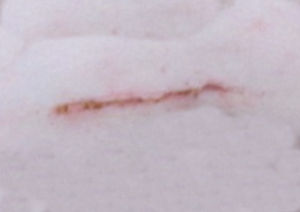
Day 4-5
As the incision continues to heal, a mild amount of scabbing, bruising, and scabbing may be seen.
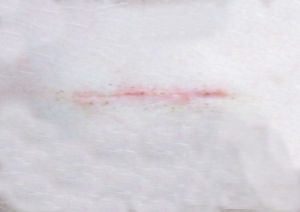
Day 10-14
By day 10-14, the incision should be fully healed. The incision here is barely visible, with no noticeable redness, swelling, or discharge.
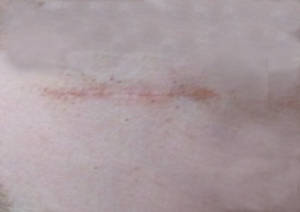
Second case: healing process of an incision after a Luxating Patella (Knee) surgery
We have provided below images depicting the various healing stages of an incision following a Luxating Patella surgery for a 6-year-old dog:
Day 3:
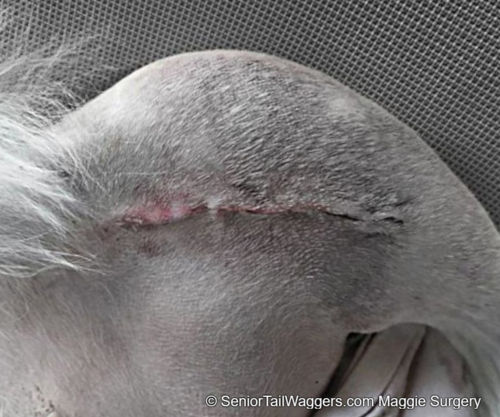
Day 6:
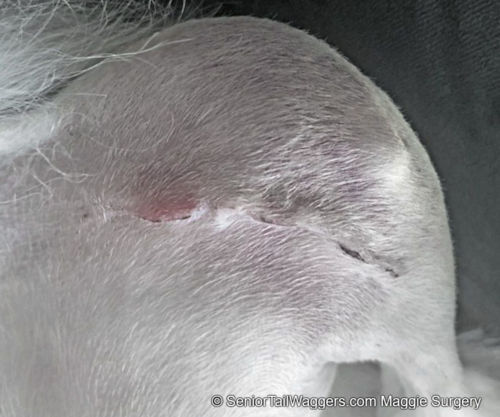
Day 8:
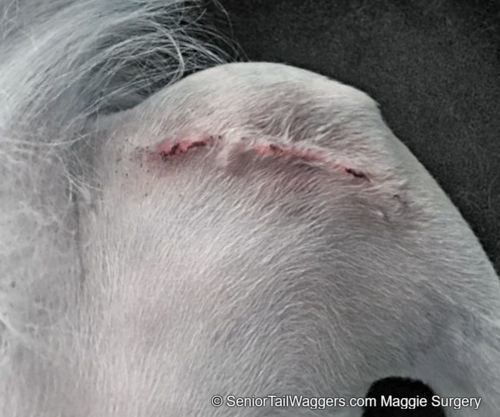
Day 12:
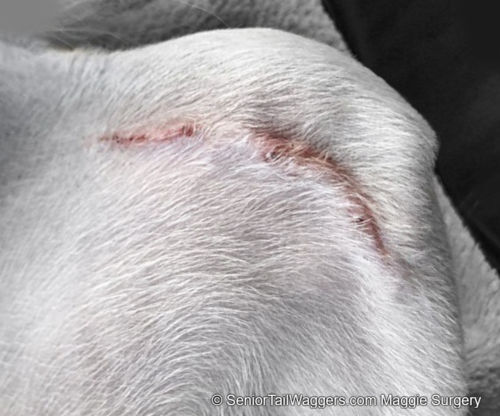
Day 16:
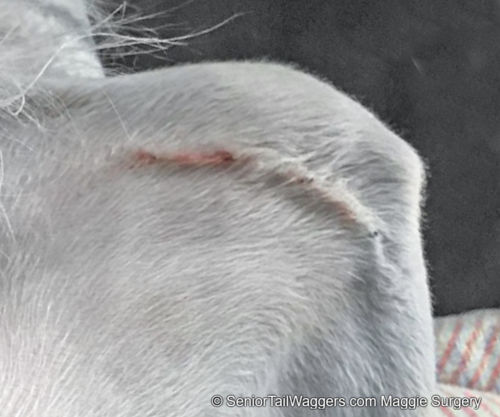
Day 25:
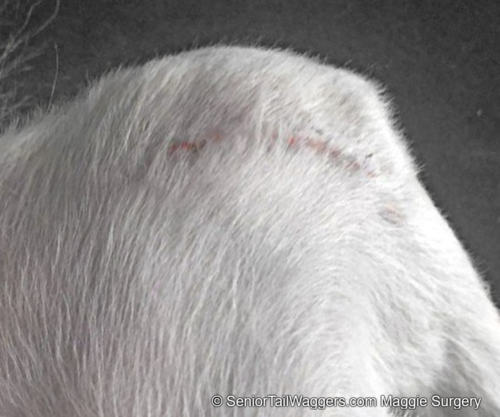
If you are unsure about your dog’s incision healing, take a picture of your dog’s incision and send it to your veterinarian.
What a normal neuter incision or scar looks like in dogs
A neuter surgery is less invasive than a spay surgery. The testicles are pushed up and removed one at a time via an incision above the scrotum. The scar size is usually around one inch in length but will depend on your dog’s size, age, and breed.
Like with a spay, the suture material is often buried within the skin, where it will dissolve over time. The scrotum is not removed, but the saggy skin will usually shrink over time. A small amount of bruising and swelling of the scrotum is to be expected; however, excessive swelling may be a sign of a scrotal hematoma.
The picture below shows a post-operative neuter incision with mild swelling and bruising of the scrotum:
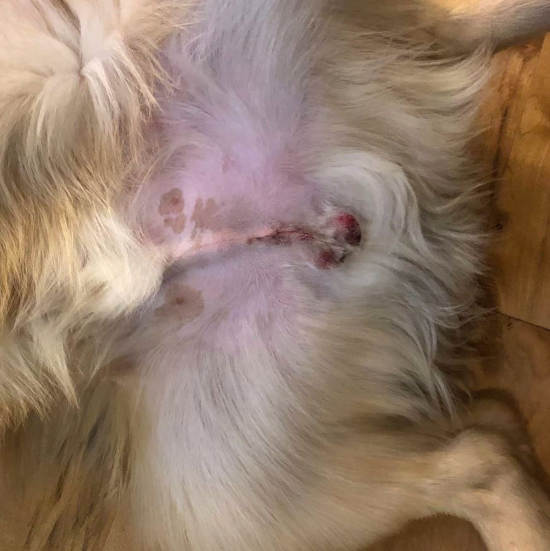
Are you worried about an incision infection?
Read our veterinarian articles about neuter incision infections or spay incision infections. If you are worried about a lump near your dog’s incision, read our article about: incision lumps.
Possible complications after spaying or neutering
After a spay or neuter surgery, dogs may experience some of these common issues:
1. Pain
Although your veterinary team will do their best to keep your dog comfortable by providing pain medications or anti-inflammatories before, during, and after surgery, your dog may still experience some discomfort and pain.
It can sometimes be difficult to tell if a dog is in pain. Sometimes they may also be anxious or dealing with side effects from anesthesia or another type of surgical complication. If you have any concerns or notice the following signs, it is best to contact your vet.
- Not eating/drinking (Read our FAQ: Dog not eating after surgery?)
- Vocalizing or whining after surgery
- Panting, trembling, pacing or shaking after surgery
- Attempting to lick at the incision site excessively
- Flinching when touched near the incision area
- Other changes in behavior
2. Side effects of anesthesia
Most dogs are still groggy when they get home after surgery. Be sure to keep your dog quiet and confined so that they cannot injure themself. Your vet will instruct you on when you should offer them a small meal.
They should start feeling better within the next couple of days, at which point it may be difficult to keep them quiet. Young, healthy dogs usually bounce back quicker. Read our article: Dog Not Eating After Surgery- What to Do.
3. Appearance of the incision
It’s normal for the incision to be a bit swollen or bruised after surgery. The intermittent seeping of a small amount of blood within the first 24 hours is also normal, especially in dogs who are more active.
However, if the swelling doesn’t go down or if you notice discharge, excessive bleeding or bruising, or signs of infection, be sure to contact your veterinarian.
- Bleeding: Excessive bleeding can be a complication of surgery or due to a clotting disorder. It is important to contact your vet if the incision is still oozing after 24 hours, if bleeding is excessive, if your dog’s gums appear pale, or if they are lethargic or weak.
- Swelling: Excessive swelling may be a sign of a suture reaction or a seroma (fluid pocket at the surgery site). Large breed, mature male dogs often develop scrotal hematomas after a neuter, in which the scrotum swells and fills with blood. In severe cases, another surgery may be needed to address this. Icing the area may help reduce swelling if tolerated.
- Bruising: In most cases, a small amount of bruising is normal. This may be especially evident in light-colored dogs. If bruising is excessive, it may be a sign of a difficult surgery or underlying clotting issue.
- Infection: Infection can occur if the incision site isn’t kept clean and dry. Signs of infection include redness, swelling, discharge, and a foul odor. Some dogs may try to lick or chew the incision site, which can cause irritation, infection, and delays in the healing process. View our article about spay incision infections.
- Dehiscence: If you are concerned that the incision is opening up, contact your vet right away.
Veterinarian Tip: To avoid the above complications, ensure your dog is not licking the incision or rubbing it on the ground.
4. Decreased bowel movements
Due to the effects of anesthesia, many dogs may not poop for several days after surgery. As long as they are not straining and are doing well otherwise, there is no need to be concerned. Read our veterinarian FAQ about constipated dogs after surgery.
5. More serious complications
Vets agree that the benefits of spaying and neutering outweigh any associated risks. However, every surgery comes with risks and possible complications. More serious complications from spay and neuter surgeries include a reaction to anesthesia, excessive bleeding, infection, and herniation.
How to help your dog recover faster
1. Follow your veterinarian’s post-op instructions: Your veterinarian will provide specific instructions on how to care for your dog after surgery, including medications, feeding, and exercise restrictions. Follow these instructions carefully to ensure your dog’s smooth recovery. Your vet will also let you know if and when a recheck appointment is recommended.
2. Limit your dog’s activity level: Keep your dog calm for 10 to 14 days after surgery. Avoid activities such as running or playing that could strain the incision, and only take your dog out for short walks on a leash to go potty. Swimming and bathing should also be avoided during this time frame. If you have an especially energetic pup, ask your veterinarian about prescribing medication to help keep them calm and quiet.
3. Check the incision regularly: Look for signs of redness, swelling, or discharge, which could indicate an incision infection. Contact your veterinarian if you see any abnormalities.
4. Prevent licking: Prevent your dog from licking or chewing the incision site by having them wear an E collar at all times when unsupervised.
5. Always contact your vet with any questions or concerns. Don’t hesitate to reach out to your vet if you’re unsure of your pup’s healing process.
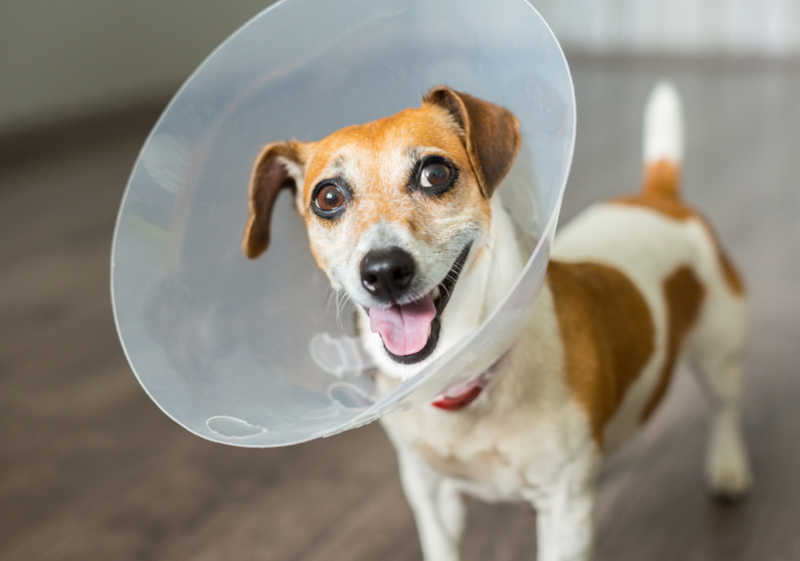
Related posts about surgery incisions:
Related posts about spaying:
 Incision Lumps and Suture Reaction in Dogs (After Surgeries) - Your dog has just had surgery, and you are anxiously watching them for any sign of complication. You want their… [...]
Incision Lumps and Suture Reaction in Dogs (After Surgeries) - Your dog has just had surgery, and you are anxiously watching them for any sign of complication. You want their… [...] Timeline for Dog Spay Recovery [By A Spay Surgeon] - Dog spays are an extremely common and effective surgery. Veterinarians have been performing dog spays since the 1970s on a… [...]
Timeline for Dog Spay Recovery [By A Spay Surgeon] - Dog spays are an extremely common and effective surgery. Veterinarians have been performing dog spays since the 1970s on a… [...]Disclaimer: This website's content is not a substitute for veterinary care. Always consult with your veterinarian for healthcare decisions. Read More.




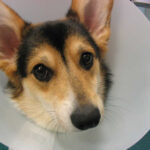
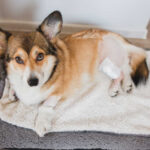
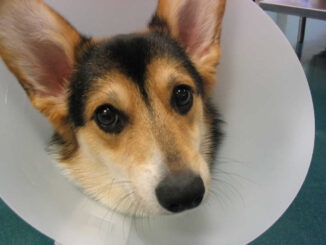
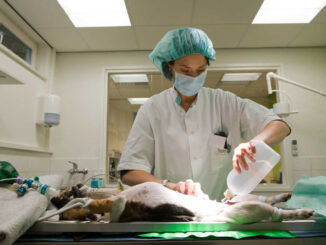
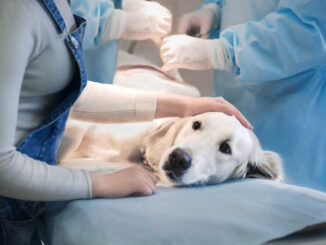
Be the first to comment